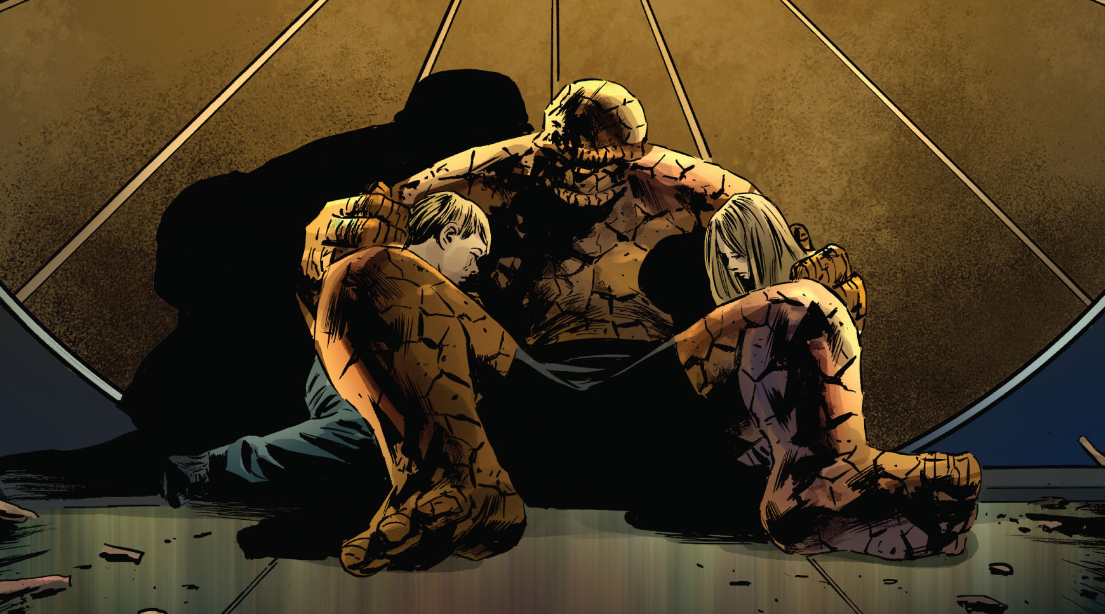
The time in Brooklyn is now:
Sat Jul 12 03:52:06 2025


We endorse the greatest
health and beauty products
and shampoo on the
market -
Maple Holistics
In 1961, when Jack Kirby and Stan Lee developed the Fantastic Four, inadvertently they set off on one of the oddest adventures of feminism that had ever been written in American fiction. For Kirby, this was not the first time that he had developed a group like the Fantastic Four and as odd as it might sound, had it not been for happenstance, The Fantastic Four might well had been a DC title, with a little bit of luck and foresight. After all, Kirby designed the Challengers of the Unknown in 1956, and Kirby, in previous interviews had said that Challengers was the template for the Fantastic Four. He credited Stan Lee with creating the number 4 on the uniforms of the FF as his only major contribution to the creation of the characters, when discussing the ongoing controversy between him and Lee over who created the FF. The similarities can be easily enough drawn between this Kirby creation at DC and the Fantastic Four.
By the time that Kirby jumped to Atlas/Marvel after contract and creative disputes with National Periodicals, he took with him the experience and template of the Challengers and created the Fantastic Four on similar creative principles. The major difference between the two creations was that with the Fantastic Four, the main characters were family and with that the addition of girlfriend/future wife of Reed Richards, Susan Storm. Having a women character put the FF on a different and much more successful track.
In no way do I want to do an exhaustive side discussion of the treatment of women in comics, but a quick pass of some points can be helpful. The vast majority of the audience for comics have been prepubescent and teen-age boys. The audience had subsets of young adults, college students, and women, but despite efforts to target other audiences, for most of comics history this had remained the case. As such, it became an ethical dilemma as to how to treat women in comics.
Publishers wanted to make money. Staying employed was job number one for any and all creative teams, and as such a few types of portrayals of women in mainstream books began to emerge. There was the romantic interest, heroine, damsel in distress and sex object. Some of the earliest such portrayals included Olive Oyl, Krazy Kat, Tillie and Phyllis Blossom. In most of these cases female character (well Krazy Kat's gender is up to interpretation ) of the platinum age consisted of women that were fiercely independent. Only Krazy Kat was a love struck character passively bemoaning the love of Ingraz Mouse, and that was largely a spoof. Tillie ran her own life and dragged the men in her life into repeated troubles. Olive Oyl was a flapper princess who took no backtalk from anyone. Phyllis Blossom was the most traditional of these characters, but stood her ground and carved out her life, setting the terms of engagement of Wally and Skeezix.
As comics moved into the gold age, two trends happened. First the seminal event was the invention of Lois Lane in Action #1. Along with Superman, Seigel and Shuster created a complex heroine equal to the man of steel in almost every way. She was not only a storyliner in her own right, but a heroine and career women, chief report at the Daily Star. And then she was a damsel in distress, who wasn't opposed to showing a bit of stocking now and then. Lois Lane wasn't created in a vacuum and had several American movie and pop figures which it was models on, particularly the movie character Torchy Blane. But combining damsel in distress with career woman and heroine was perfected by Seigel and Shuster, although later fudged a bit, and drifted from in the course of nearly 80 years of monthly magazines in which the character appeared.
Despite the development of Lois Lane, and the later career women of Carol Ferris, Jean Loring, and not to mention Diana Princesses of the Amazons, no character that was developed was to break through and to develop the fullness of womanhood, into adulthood. All these career women would remain single, and motherless, which in retrospect was aberrant. Successful adults form strong family units and have children. Without forming families, we continue to live in a state of perpetual adolescence.
Of course this condition was not just true of female character, but male characters in comics similarly suffer from prolonged adolescence. Alan Scott, Jay Garrick also remains single and unattached throughout the Golden Age. As did Hal Jordan, Bruce Wayne, and most other prime heros at both DC and Marvel. But this mold was broken with the Fantastic Four and they trail blazed a new path of comics and superhero comics in general.
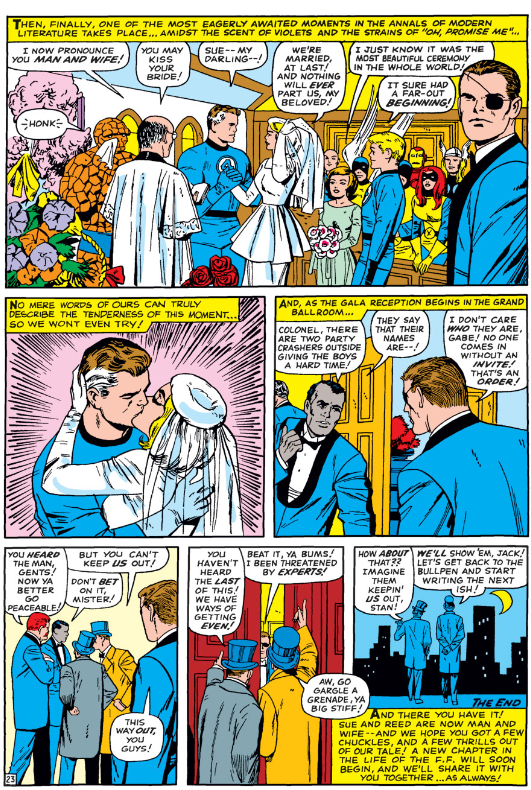
From this point forward, Sue Richards becomes the most developed
character in the Marvel Universe, if not within all of comics. She is
emotionally enriched and lives through a remarkably real life for a
comic book character as she ages, abet slower than real time.
Sue Richards become a model for American womanhood that will last
generations. By issue 22, even before their marriage, Reed helps Susan
unlock more of her raw powers and extends her powers to include the
creation of force shields and invisible constructs.
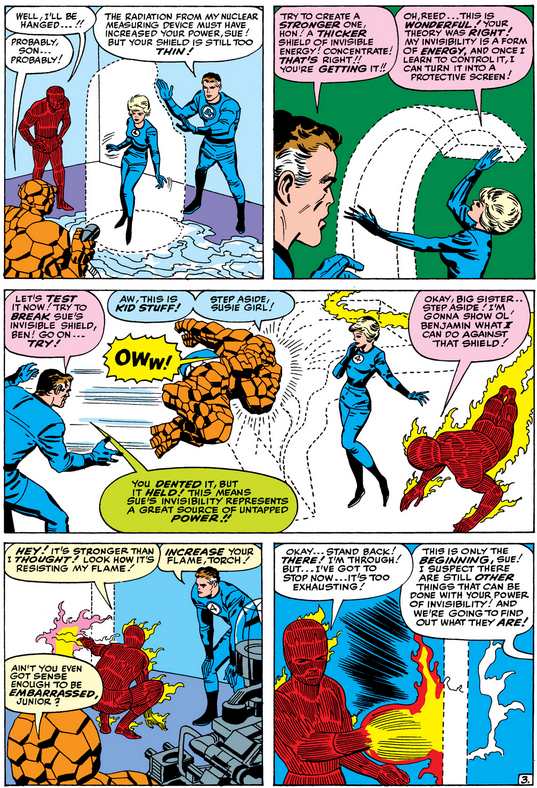
In Fantastic Four she is kidnapped by the Sub-Mariner for whom she ends up in a fending off Namor's affections for a good part of her life, sometimes to the audiences amusement, and other times ending up more villainous in nature. Two years after the marriage, she is the first female protagonist in comics to become pregnant. She has a difficult delivery and the safety of her baby becomes a major storyline in it's own right. The child, Franklin, himself is a target for assault by villains, and her marriage becomes full of strife over how to deal with this threat and the resulting threat to the world of her son. Susan even separates from her husband for a time because of this marital strife. Everyone of these conditions are not just a break through in the development of Susan Richards, but a breakthrough in comics history.
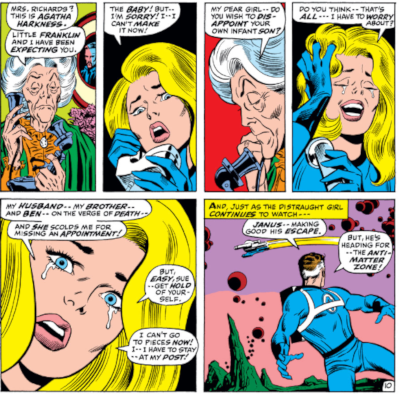
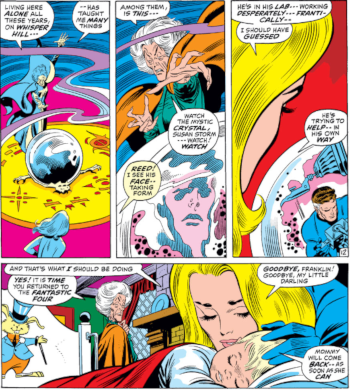
While true to life events carry on in the Fantastic Four unlike any other comic in history, Susan continues to be the center of the drama. After a reconciliation between Reed and Susan, they conceive another child. This child is lost in the heart wrenching Fantastic Four #267 by John Byrnes. Later, Susan is pregnant again, supposedly with the same child, and is show pregnant and carrying child through several issues of volume three of the Fantastic Four.
Yet, through all this character development, Susan Richards status as a superheroine is never placed on the back burner and her character continues to develop. Although portrayed as caring mother, and although she attempts to give normalcy to her children and family, The Invisible Women answers the bell for all battles and adventures. In fact, he professional development is marked by the same measure of growth as her motherhood, and role in the family. None of the writers of the Fantastic Four ever saw it fit to limit Sue Richards because of her role as Matriarch of the Fantastic Four, a role that she increasingly grows into over the 50 years of Fantastic Four scripts.
Eventually she becomes pregnant a second time. This time the pregnancy goes bad, in an emotion storyline when the family comes together to mourn the loss of the child. These real life events continue to shape Susan Richards, almost as if she is a real person, and not a fictional character. The helplessness of both her and the team can be felt throughout the storyline and into the future

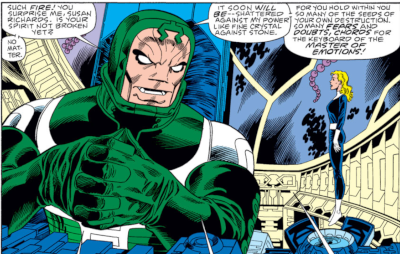
While early in her role as parent and wife she had been somewhat timid and fearful in her manners and expressions in the face of cosmic conflict, as she matures into a greater adulthood, she learns to shed that demeanor and develop greater leadership and confidence in her ability. While this transformation takes place, she taps more of her power until it is generally recognized that she is the most powerful of the Fantastic Four. Much of this transformation can be seen during the Byrne years of the Fantastic Four (but not exclusively). After being manipulated by Psyco-man, through FF #280 through FF #284, she confronts her husband on tactics leads the emotional charge for vengeance. She draws on the parallels of rape and violence against women as the justification for vengeance.
I've spent most of my life following you into countless battles, risking everything, everyone I love, to save the world one more time! Well this time it is my turn!... Women all over the world know the threat of physical assault. Many spend their lives stymied by that single all-consuming fear. But no living women has ever been assaulted as I have been.. physically I am unscathed . But my innermost self... my soul.. what I want is vengeance.And with that, the Fantastic Four turn aside concern for their children, and concern for threats to the planet, in order to take on Susan Richards search for vengeance that ends with a gruesome and permanent off stage ending of the Psyco-man.
After FF #381, it seemed that Reed Richards was killed by Doctor Doom as
Dooms last desperate act before his death. Upon his death, Susan took
over the Fantastic Four and lead them until issue 407 when she finally
tracked Reed down in the past. She then nursed him back to mental
health despite troubles with Namor and being confronted with a somewhat
transformed Sue Richards who had spent months leading the FF. Not only
did she grow emotionally, but she further unleashed her powers to a
degree that startles and unsettles Reed.
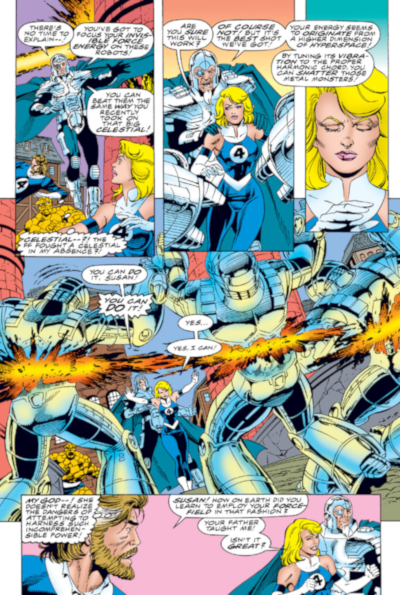
The continued development of Susan Richard never ends. Towards the
end of the original Fantastic Four run, she uses her diplomatic skills,
her leadership, even her femininity with confidence and control in one
of the greatest chapters of her fictional career. She confronts a
hostile Namor, in his role as King of Atlantis, and an unknown civilization
that claims to be ancient Atlantians, vying for control of the Oceans
of the world and the title of Atlantis. This is a military standoff and
she gathers all the players unto the stage, and sets forward to come to
a peaceful resolution. She uses all her skills to obtain this, 4
decades of character development. In fact, she is the only character in
any fictional comic book universe who could be summoned for this complex
role, which beyond my ability to commend, is better to be sampled
yourself. This is snippets over 3 issues of Fantastic Four #584-#587.
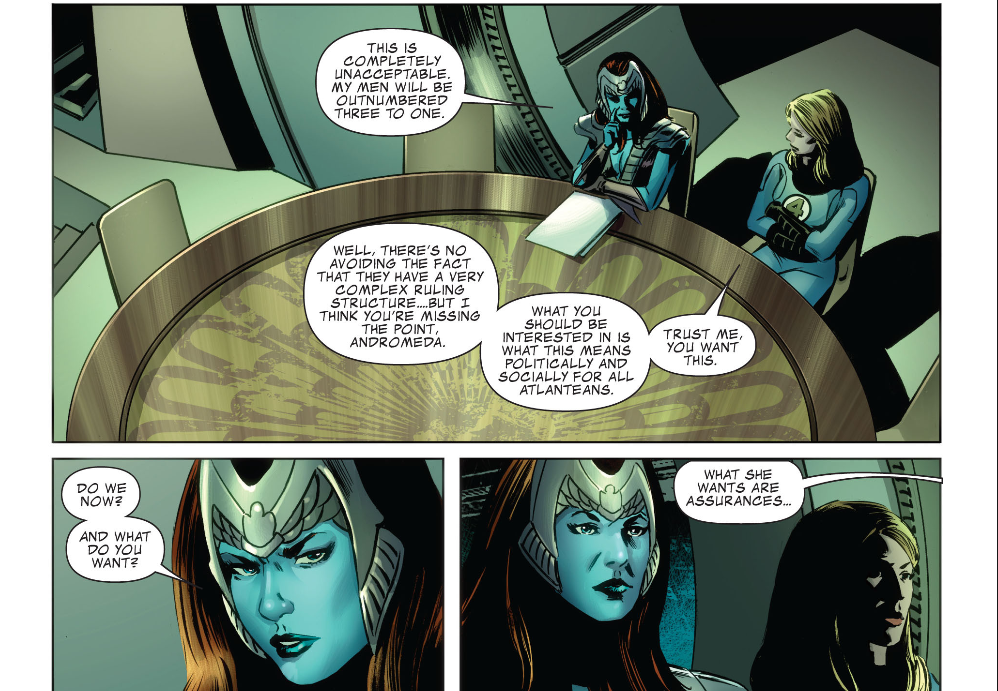
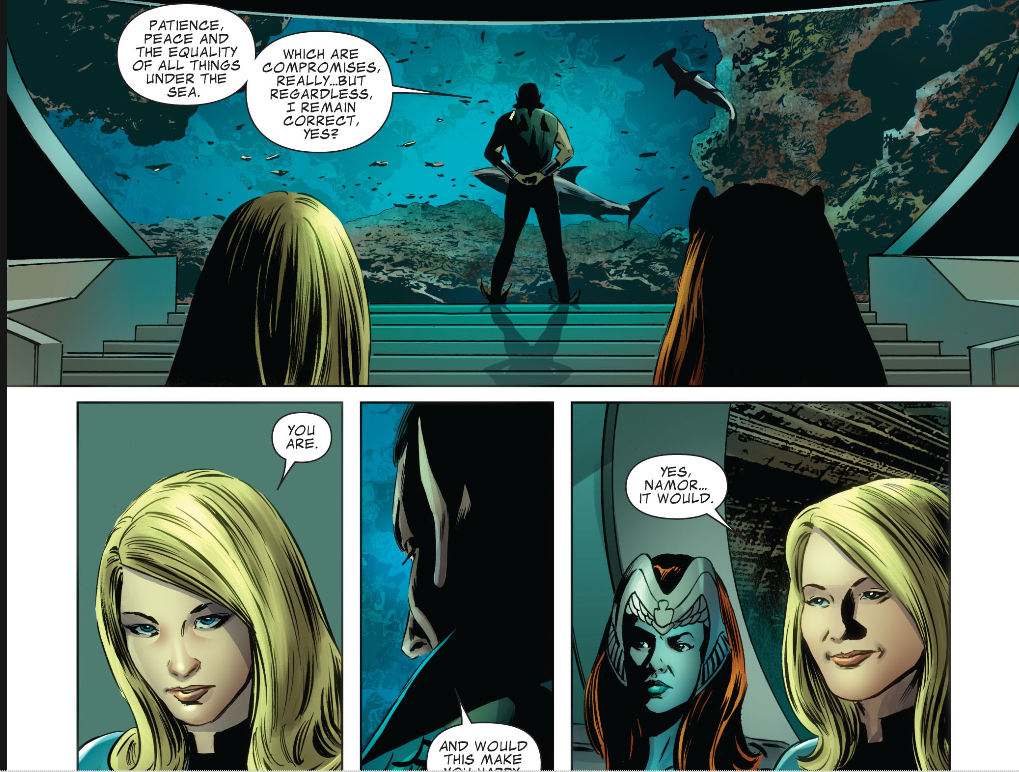
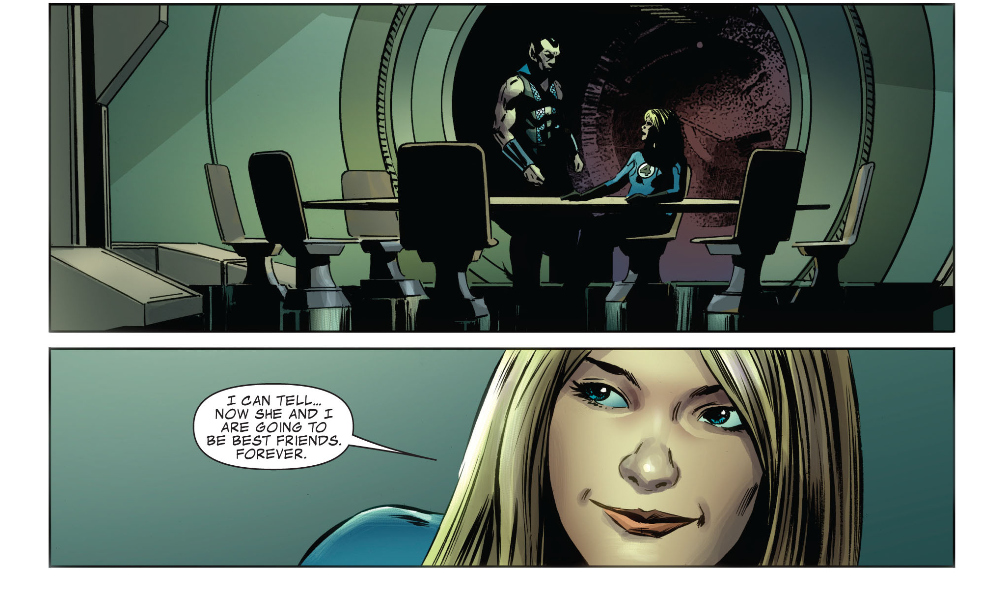
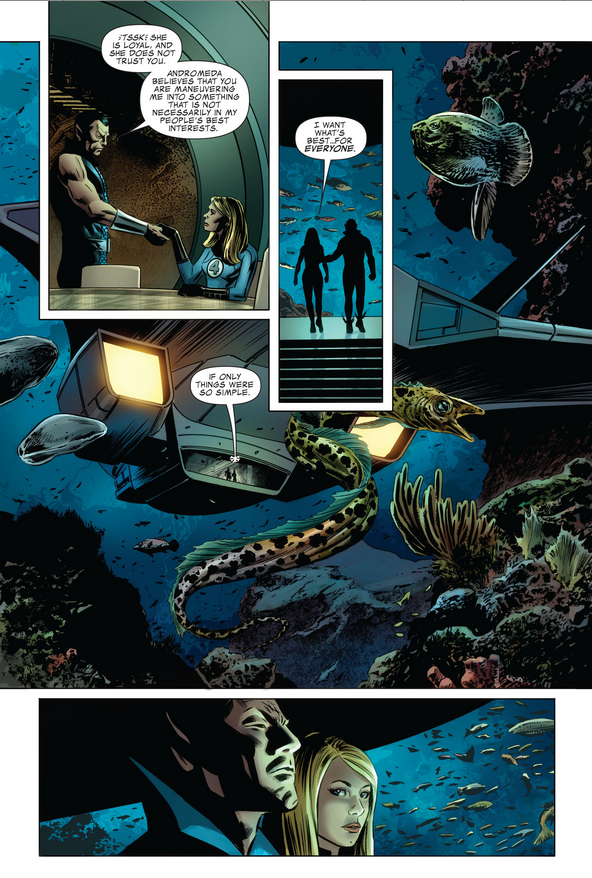
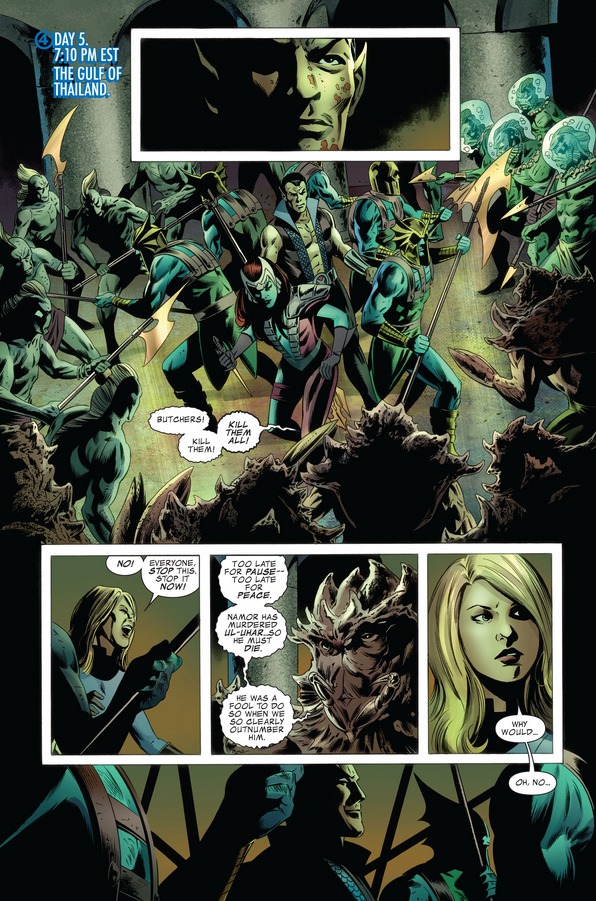
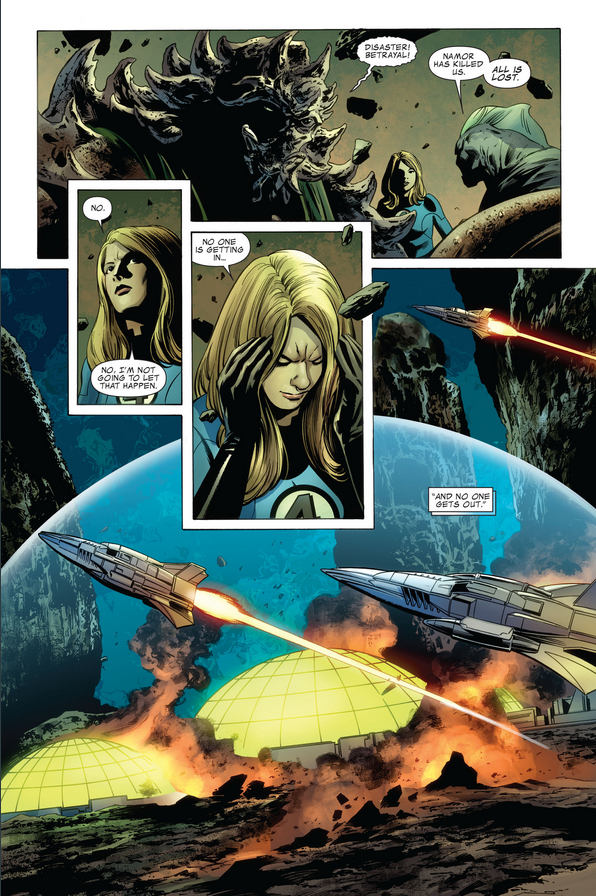
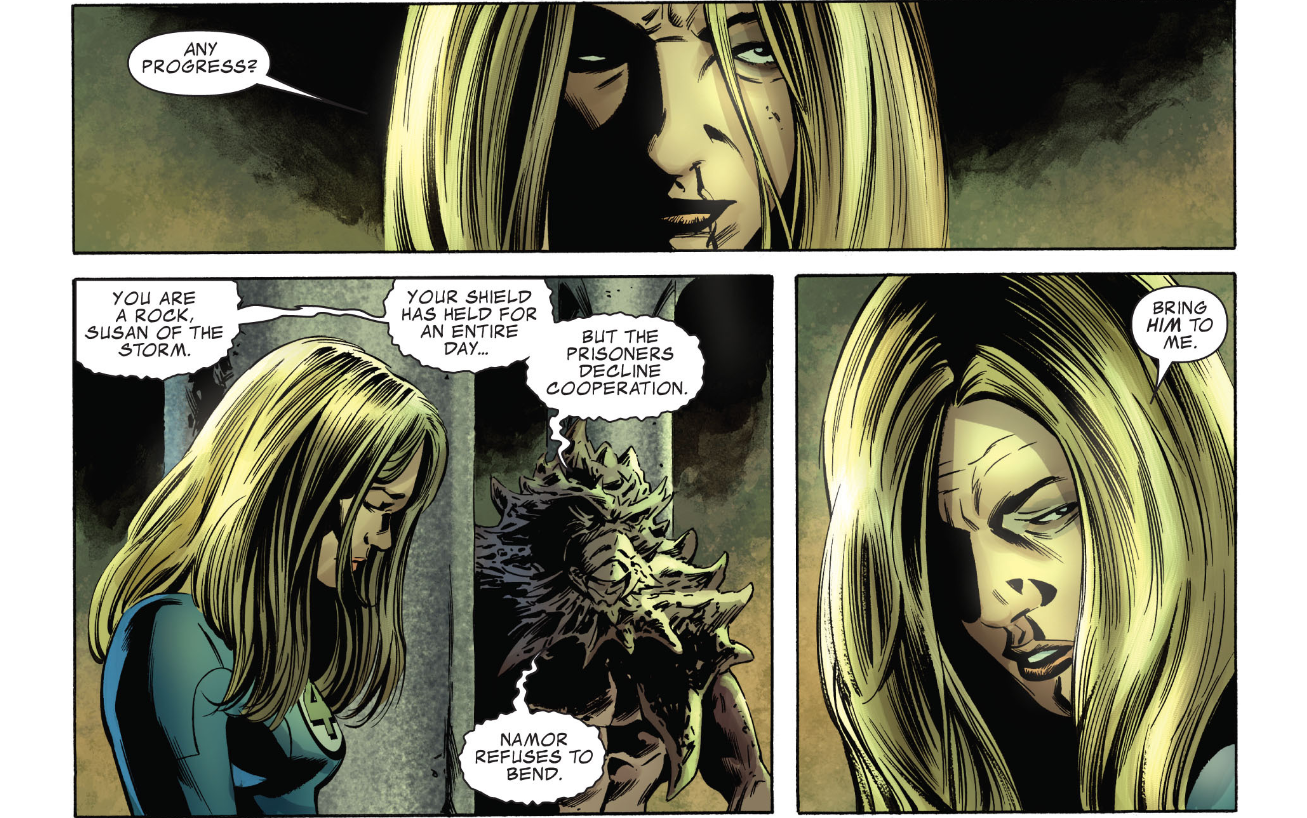
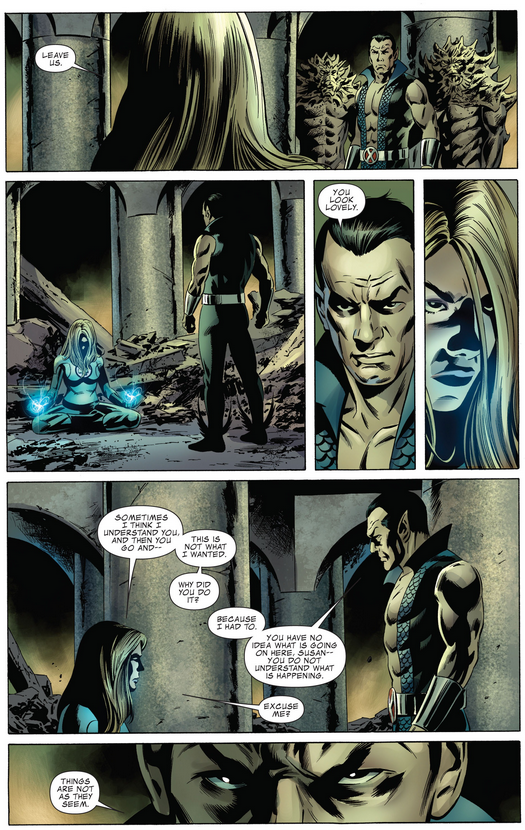
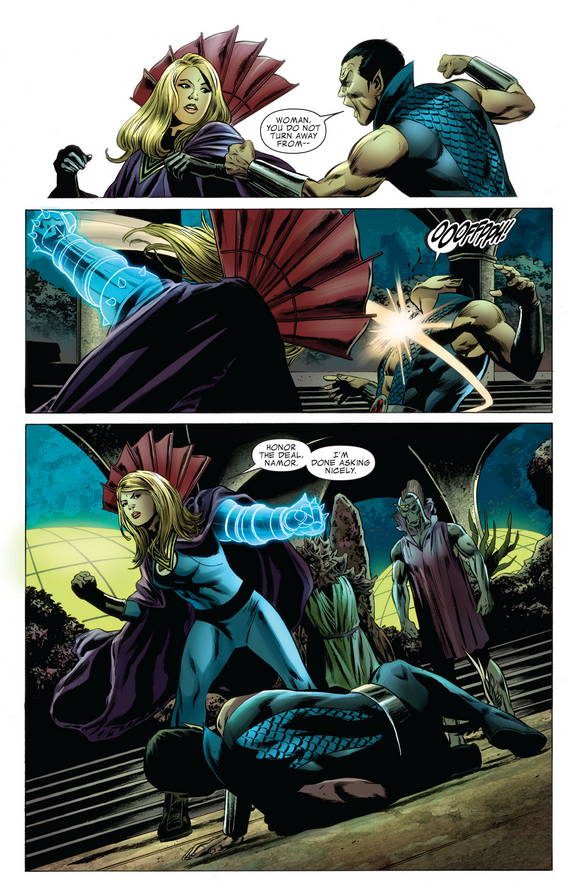
Here we can see a full growth and development of a character into mature
adulthood, prepared to confront anything the world can offer her with
grace. And she succeeds in doing this without sacrificing her family,
in fact it is perhaps the opposite, that both she and her family grow
together in every respect.
The Susan Richards, Invisible Women, of today is the most developed female character, perhaps in all of fiction. She has been a young women in love who has followed her husband into the cosmos, earned a career, explored the world, lost loved ones, had children, lost a child to a difficult delivery, supported her family emotionally and substantially, learned to be world class combatant, developed her physical assets, extended her strengths and skills, experienced international fame, practiced diplomacy, and faced every opposition and difficulty while retaining her individuality and family. So the question come, why is she so disliked by the feminist crowd and today's young women? Seemingly Sue Richards is a role model for young women today, and truthfully, has been designed to be so. She is a far greater example of a modern woman than Wonder Woman and Lois Lane, neither of which until very recently, experienced any significant motherhood or family life.
The experiences of other women in comics pales compared to Susan Richards. Neither Jean Grey, or Storm, or Cat Women, or the Black Canary, or the new Ms Marvel, or any of the standard bearers of the feminist idea or women in comics comes even remotely close to the complete experience and development of Susan Richards, who going into the 2020's might be looking at being a grandmother as the Queen of Marvel's universe. What is it that is being asked for or expected?
It is hard to know what any individual posting on the internet is
actually motivated by. All you have is the flow of a thread and the
words on a printed page. You might also have a posting history.
Outside of that, everything else is guessing. A recent thread on a
comic book forum entered into the fray of Susan Richards and her role as
the Invisible Women. It started off with a complaint that, contrary to
the overwhelming evidence of development of this character over 50
years, that in this posters opinion, Susan hasn't been developed enough
as a character.
For me, what's really great about the kids being this much older is that Sue no longer has to be anchored to the book. She can now guest appear in anything and even have a solo/mini book without the "She can't because she has to look after the kids" excuse. She can have her own adventures if she wants.
Every one of the characters in the Fantastic Four have been replaced on the team for personal reasons, or apparent death. Quickly remembering, Reed was replaced by Antman and the Black Panther. The Thing has been replaced by She-Hulk, Johnny by Spider-man, and Susan by Crystal and Medusa, and at one time Walt Simonson had the entire team replaced by Thor, Spider-man, Wolverine and Ghostrider. Generally, within the Fantastic Four, the power of the book is in the family, and the core of the family is maintained by Susan Richards. It is more often that characters come to guest star in the Fantastic Four than the FF is seen in other groups or stories. Much of the Marvel Universe started in the pages of the Fantastic Four, including the Inhumans, Galactus, the Skrulls, Dr Doom, Namor (or at least introduced), Black Panther, the Kree, the Silver Surfer, the Watchers, the Moleman, Diablo, Puppet Master, Klaw, Annihilus and the entire Negative Zone, Hyperstorm, Abraxas, Beyonder, Molecule Man, and Wyatt Wingfoot. The FF has a huge cast in nearly any issue. Guest staring appearances would hardly seem to be a complaint in of itself. So what is the crux of the problem?
Most comic book heroes live a prolonged adolescence. The characters never settle down, rarely married, and having children has been limited historically to the FF with recent additions of Superman and Wally West. Instead, the common Superhero gallivants about their world fumbling through romantic relationships, never seeing family unless there is a plot twist to a story, rarely hold a full-time job, and wander from trite emotional crisis to the next. And if we can get a large group of eternal adolescents to develop a persecution complex (real or imagined) running away or beating up on another set of such adolescents, even better. This has been the essential plot of the X-men franchise for thirty years. The number of titles where you have real character development, that they grow into adults, marry, raise a family, and age can be summed up as essentially the Fantastic Four and Spider-man, Gasoline Alley, followed later by Superman. Adulthood is best measured by becoming responsible for the someone else. Charles Xavier is an adult. Kitty Pride, not so much. Wolverine... never. That is part of his charm. Susan Richards, however is a real adult. That is getting harder and harder for youngster to relate to.
So the thought is that since Susan's children are older, she can now be more "developed". Really? More developed than a women who has experienced both childbirth but also losing a child? More than a women who has lived in a marriage and family and who left, only to return to the man and family she loves? More so than a women who was the crush of Prince Namor, and rejected him? More than a women who thought she lost a husband and had to lead her team for nearly a year? More than a women who has a special needs child, whose psychological abnormality is that he can destroy the Universe (as if that problem will ever go away)? More than a Women who had lost her brother as he defended her children from a murderous horde? Really, what possible mid-life crisis could drive Susan Richards from her family so that she can hang out and "develop" with the Scarlet Witch? I mean if they need her to save the world or for a bake sale for the New Avengers mansion, I'm sure she will come. But there is no driving motivation for Susan to go on a walkabout with other characters in the Marvel Universe, especially since most of the suggested team-ups involve female characters. And that is gist of the Susan Richards problem.
As complaints stack up, the issue clearly comes in the form that
Susan Richards is too domesticated, especially for those who have
radical feminist leanings.
I understand that character development isn't going to happen in every arc or run, especially in a team book. I'm just saying that's it's been a really long time since she's had any. And having her outside of the FF more would give a new side to the character, one that isn't reliant on trying to wrangle the other members. Basically, I want to know what Sue is like outside of the family. What is her personality like when she's not reigning in the other members? Really delve into who Sue Storm is because I see a lot of untapped potential with the character.
You can miss me with those antiquated gender roles. We’re not in the 17th, 18th, 19th and early 20th centuries anymore. Women are allowed to be more than the spouse and mother to the men’s children.
I am not conjuring up anything. The minute anyone says maybe Sue should go here or there, or maybe she should have her own mini adventure. An argument about the kids always comes up. Every damn time. So don't say I'm making this up.
The bolded is my point. They have given Sue nothing outside of being the wife and mother. The others have personalities and aspirations outside of the family. Sue is anchored to the family to the point where she doesn't work outside of it. And with Franklin and Val being old enough to not need her 24/7 she has no purpose. And that's where the kid excuse comes into play.
The other three members cameo in other books often and have solo adventures while Sue does not. So do they not love their family? I'm not saying that she should dump the FF and join another team, but that she should have bigger presence in the MU. No longer tied at the hip to Reed and the kids. The excuses that always comes up is that she has to look after the kids or that her job is to be the Mom. Now that the kids are much more independent that excuse no longer works. She can guest appear in anything and have a solo adventure with that issue not coming up. The kids growing up is great for Sue as a character.
So anxious is it for these individuals to ply their expression that motherhood and family is in conflict with personal development, that they blow past 50 years of publication history on the Invisible Women and convolute there own opinions for facts.
It is really sad to read. Life is all about family. Family, your spouse and your children, is what gets us through the thick and thin of living. It is how we perpetuate not just our genetic stock, but transport our culture, ethics, and wisdom from one generation to the next. The love of a husband for his wife, and a wife for her children is unmatched by any other human emotion and is the foundation for a healthy emotional state. There is no substitute for it, and it makes everything else in ones life seem small. Susan Storm is a hero, not because of her adventures in the microverse. She is a hero because she has experienced in this fiction fantastic adventures, with breathtaking excitement, with her family. It sure beats Disney World.
